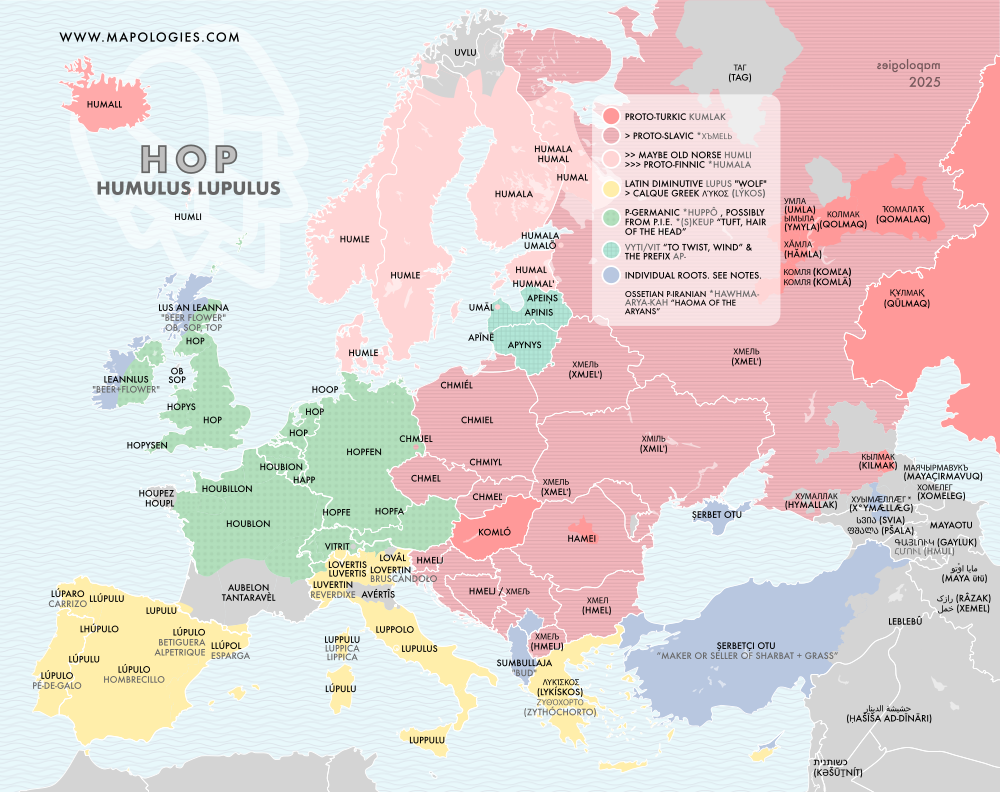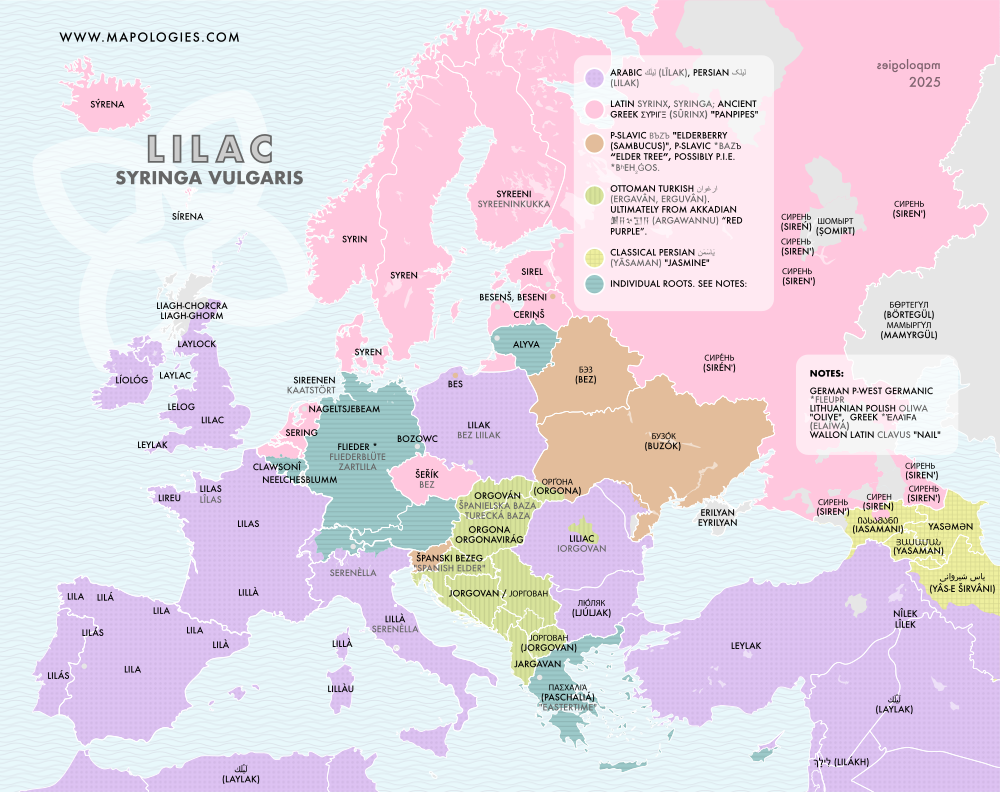In this section, we will explore the fascinating etymologies of flowers, the reproductive structures found in certain plants known as angiosperms. Flowers are typically composed of four main parts: petals, which are the colorful and fragrant components that most people easily recognize; as well as sepals, stamens, and the pistil.
Artichoke

The word artichoke is a true linguistic traveler. The English term most likely derives from the Occitan artichaut or Northern Italian articiocco, similar to many other European forms. In most languages, the word remains close, however, some forms stand out. For instance, Polish uses karczoch, which differs in form but still resembles modern Italian carciofo.
The path into Europe likely began with Old Spanish alcarchofa, which was borrowed from the Arabic al-ḥaršūfa. This Arabic term, in turn, might trace back to ancient languages such as Akkadian or Persian, although its precise origin remains unclear.
A Southeastern word
Despite the overall consistency across many languages, some areas show interesting divergences. The most significant alternative form appears in Southeastern Europe. Ancient Greek used the term kinára (κινάρα), which survives in Modern Greek as αγκινάρα (agkinára) and nearby languages: Turkish: enginar, Romanian: anghinare, Albanian: angjinare.
Phono-Semantic Matching in Arabic
One fascinating case of complex borrowing appears in Modern Arabic. The term ardi šawki (أرضي شوكي) literally means “earthy thorny”. Interestingly, this modern neologism sounds remarkably close to artichoke. It’s not a coincidence! This is an example of phono-semantic matching—a process where a new word is coined to resemble an existing foreign word both in sound and meaning. ,
The Spanish Doppelganger
Spanish presents a particularly intriguing case with two distinct words for artichoke: Alcachofa and alcaucil. At first glance, these words might seem closely related, starting both with “alca”. While Alcachofa comes from Arabic al-ḥaršūfa, as mentioned earlier, Alcaucil is derived from a different Arabic root: al-qabsil. This word was borrowed from Latin capitia, meaning “heads,” likely referring to the shape of the artichoke flower.
Cauliflower

Cabbage’s flower
Brassica oleracea is a plant species that includes many familiar cultivars, such as cabbage, broccoli, kale, Brussels sprouts, collards, Savoy cabbage, kohlrabi, gai lan, and cauliflower. The last of these is typically cultivated for its “curd,” which consists of the immature white or off-white flower buds. Because of this, in most languages it is referred to as a “cabbage flower.”
In some languages, however, the name has evolved through borrowings from foreign languages and subsequent orthographic changes. For example, English cauliflower developed from Middle English cole-florye “cole-flower”. In Swedish, the modern form blomkål derives from Dutch bloemkool, while in Polish kalafior comes from dialectal Italian caulofiore. German presents an interesting case, as it has two common terms: Blumenkohl (Literally “flower-cabbage”), and Karfiol, which is again an Italian borrowing.
Some Slavic languages just used a word derived from “flower”. See Sloven cvetača (from cvet)
Greek names
In the East, there are at least two different Greek etymological roots: The first one in Modern Greek κουνουπίδι (kounoupídi), but also Romanian conopidă, possibly originated from κάνωπον (kánōpon) “elderflower”. The second root κρᾰ́μβη (krắmbē) “cabbage” was borrowed into many languages: Arabic: قَرْنَبِيط (qarnabīṭ) or Turkish karnabahar (the ending bahâr came from Arabic بهار “spring”.
Hops

Hops are the flowers of the plant Humulus lupulus, used to flavour beer. The English common word hop comes from the Proto-Germanic term huppo, which is also the source of German Hopfen and even French houblon. The scientific name needs a longer explanation.
In many other languages, however, the word derives from a Turkish root, kumlak. This is the source also of the first part of the scientific name. This form spread across Eastern Europe—appearing in Russian хмель (xmelʹ), for example, and Romanian hamei—and even reached the North, where Danish, Swedish, and Norwegian use humle.
In the south, the dominant root is the Latin lupus, meaning “wolf,” apparently referring to the plant’s aggressive, almost predatory growth habit. This is the second part of the scientific name.
Lilac

Lilac is the common name for the plant Syringa vulgaris. The name lilac originated from the Persian word لیلک (lilak), which spread to Europe during the Arab expansion. The scientific name Syringa, however, has a different origin — it derives from the Ancient Greek σῦριγξ (sûrinx), meaning “pipe” or “flute”. Interestingly, syringa and syringe share the same etymological origin, which is why they sound alike.
Several European languages adopted forms of this term, such as Czech šeřík, Danish syren, and Russian сирень (siren’). Interestingly, the modern Persian word for lilac is now borrowed from jasmine (یاس, yās), and similar forms appear in many Caucasian languages.
In Central Europe, we also find the old Turkic name ergavan (Ottoman Turkish: ارغوان), which influenced names from Slovak (orgován) to Albanian (ergavan). However, the modern Turkish term has shifted to leylak, like the English term.
Due to their resemblance, some Slavic languages associate lilac with elderberry (Sambucus). For instance, Slovene uses bezeg, and Ukrainian бузок (buzok)—though the plants are botanically distinct.


